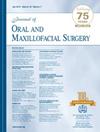Comparison of Autogenous Tooth Graft With Polylactic Co-Glycolic Acid in Postextraction Socket for Alveolar Ridge Preservation: A Randomized Control Trial
IF 2.3
3区 医学
Q2 DENTISTRY, ORAL SURGERY & MEDICINE
引用次数: 0
Abstract
Background
Preservation of alveolar ridge is required postextraction of tooth. Traditional bone graft materials such as autografts, allografts, xenografts, and alloplasts have been used for this purpose.
Purpose
The purpose of this study was to measure and compare clinical and radiographic parameters of autogenous tooth graft (ATG) versus resorbable bioscaffold polylactic co-glycolic acid (PLGA) for alveolar ridge preservation.
Study Design, Setting, and Sample
A prospective randomized controlled double-blind trial was conducted on patients who reported to our Department from 2019 to 2022 for the extraction of endodontically or periodontically compromised single rooted teeth. Patients with age >60 years, pregnant or lactating females, those with systemic and autoimmune diseases, parafunctional habits, history of tobacco or alcohol, and those on radiotherapy or chemotherapy in the last 12 months were excluded.
Predictor Variables
The predictor variable was the alveolar ridge preservation techniques and the subjects were randomly assigned to autogenous tooth grafting (ATG) and PLGA group.
Main Outcome Variables
Main outcome variables were clinical and radiographic dimensions of alveolar ridge on postoperative day 1 and 6 months after grafting. The secondary outcomes were complications.
Covariates
The demographic details were age and gender.
Analyses
Bivariate analyses were performed using the parametric tests, ie, paired t-test and independent t-test for intragroup and intergroup comparison respectively, with level of statistical significance set at P value ≤ .05.
Results
The study sample was composed of 20 subjects with a mean age of 47.40 ± 13.94 years. 45% (n = 9) were males and 55% (n = 11) females. On comparing bone levels, we found statistically significant difference in the horizontal dimension in the apical third between the 2 groups after 6 months of grafting (P = .01). There was also a statistically significant increase in the dimensions of alveolar ridge from baseline to 6 months in both the groups. No complications like wound dehiscence or presence of pus discharge were observed in Group A, while there was failure of regeneration in 2 patients in Group B.
Conclusion and Relevance
The results suggest that ATG may be better than PLGA for socket grafting due to lower risk of complications.
自体牙移植与聚乳酸共羟基乙酸在拔牙后牙槽内保存牙槽嵴的比较:一项随机对照试验。
背景:牙槽嵴的保存是拔牙后需要的。传统的骨移植材料,如自体骨移植、同种异体骨移植、异种骨移植和同种异体骨移植已被用于此目的。目的:本研究的目的是测量和比较自体牙移植物(ATG)与可吸收生物支架聚乳酸共羟基乙酸(PLGA)用于牙槽嵴保存的临床和影像学参数。研究设计、设置和样本:对2019 - 2022年到我科就诊的根管或牙周受损单根牙拔牙患者进行前瞻性随机对照双盲试验。排除年龄50 ~ 60岁、孕妇或哺乳期女性、有全身和自身免疫性疾病、有副功能习惯、有烟酒史、近12个月内接受过放疗或化疗的患者。预测变量:预测变量为牙槽嵴保存技术,受试者随机分为自体牙移植(ATG)组和PLGA组。主要结果变量:主要结果变量为植牙术后第1天和第6个月牙槽嵴的临床和影像学尺寸。次要结果为并发症。协变量:人口统计细节为年龄和性别。分析:采用参数检验进行双变量分析,组内比较采用配对t检验,组间比较采用独立t检验,P值≤0.05为统计学显著水平。结果:研究对象20例,平均年龄47.40±13.94岁。男性占45% (n = 9),女性占55% (n = 11)。在比较骨水平时,我们发现两组植骨6个月后根尖三分之一的水平尺寸差异有统计学意义(P = 0.01)。从基线到6个月,两组的牙槽嵴尺寸也有统计学上的显著增加。A组无创面裂开、脓流等并发症,b组2例再生失败。结论及相关性:ATG因并发症风险较低,可能优于PLGA。
本文章由计算机程序翻译,如有差异,请以英文原文为准。
求助全文
约1分钟内获得全文
求助全文
来源期刊

Journal of Oral and Maxillofacial Surgery
医学-牙科与口腔外科
CiteScore
4.00
自引率
5.30%
发文量
0
审稿时长
41 days
期刊介绍:
This monthly journal offers comprehensive coverage of new techniques, important developments and innovative ideas in oral and maxillofacial surgery. Practice-applicable articles help develop the methods used to handle dentoalveolar surgery, facial injuries and deformities, TMJ disorders, oral cancer, jaw reconstruction, anesthesia and analgesia. The journal also includes specifics on new instruments and diagnostic equipment and modern therapeutic drugs and devices. Journal of Oral and Maxillofacial Surgery is recommended for first or priority subscription by the Dental Section of the Medical Library Association.
 求助内容:
求助内容: 应助结果提醒方式:
应助结果提醒方式:


